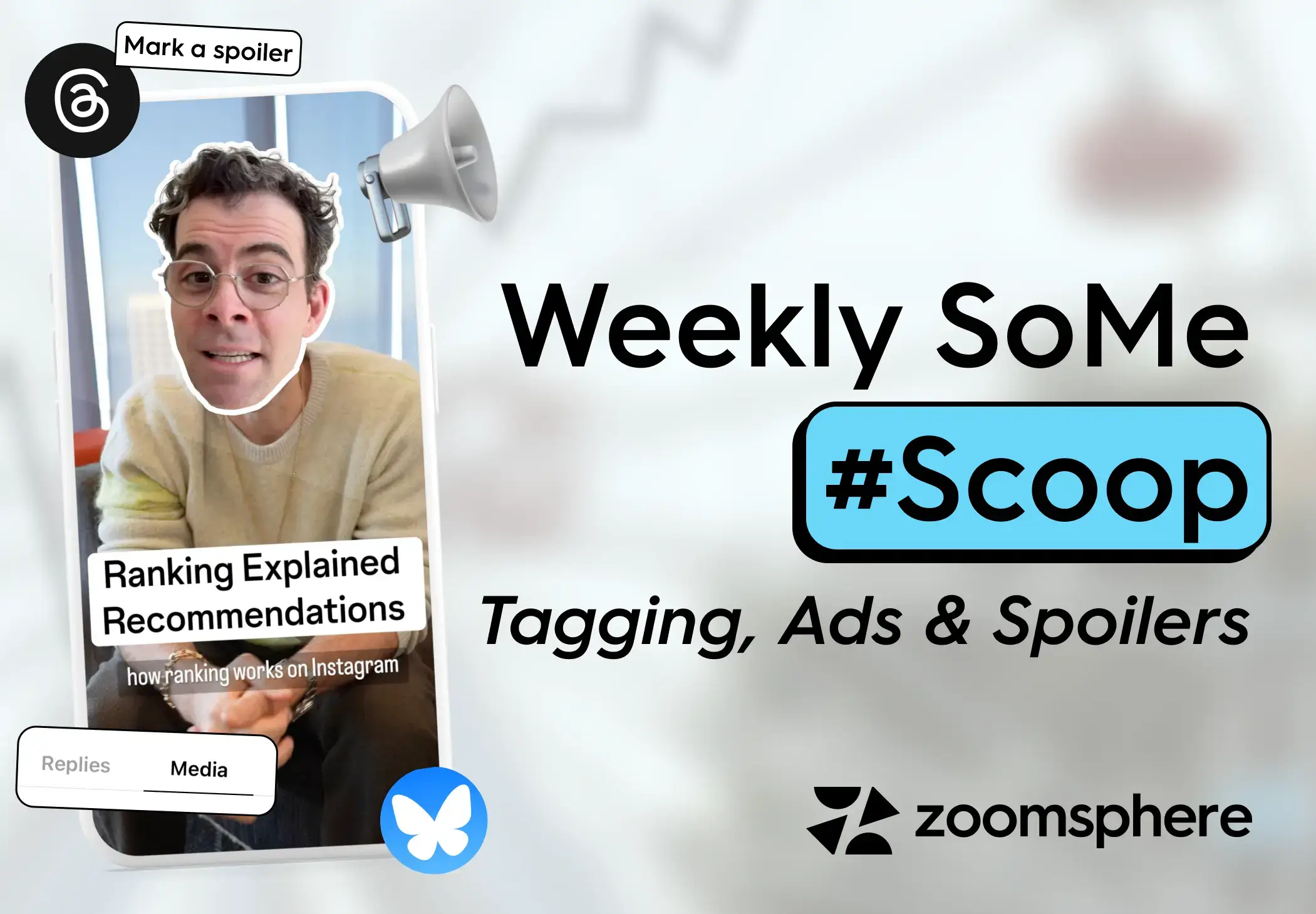#SocialMedia
Thank you! Your submission has been received!
Oops! Something went wrong while submitting the form.
%20(1).webp)

Blog
Weekly Social Media Scoop: TikTok, IGTV, Threads & More Go All-In on Engagement
%20(1).webp)

Blog
Weekly Social Media Scoop: Shared Feeds, AI Tools, and SEO Secrets
%20(1).webp)

Blog
Weekly Social Media Scoop: Recaps, Reposts, and Smarter Feeds
%20(1).webp)

Blog
Are Brands Trading Depth for Virality?
%20(1).webp)

Blog
Weekly Social Media Scoop: Hashtag Limits, Holiday Tools, and AI Sneaking Into Everything


Blog
Weekly Social Media Scoop: Share Stories, Trending Audio, and Private Chats Take Over
%20(1)%20(1).webp)

Blog
Weekly Social Media Scoop: 20-Minute Reels, AI Video Summaries, and New Podcast Tools
%20(1).webp)

Blog
Weekly Social Media Scoop: Smarter Sounds, Skippable Ads, and AI-Powered Editing
%20(1).webp)

Blog
Weekly Social Media Scoop: Ghosts, Collabs & AI Magic
%20(1).webp)

Blog
Weekly Social Media Scoop: Halloween Fonts, Custom Rings & Communities
%20(1).webp)

Blog
Weekly Social Media Scoop: Timeline Editors, Job Boards & AI Translations
%20(1).webp)

Blog
Weekly Social Media Scoop: Business AI, Edits Upgrades & Threads Goes Community Mode
%20(1).webp)

Blog
Weekly Social Media Scoop: Text Posts, TikTok Drama & AI Tools
%20(1).webp)

Blog
Weekly Social Media Scoop: 3 Billion Users, Algorithm Tweaks & Widescreen Reels
%20(1).webp)

Blog
Weekly Social Media Scoop: Instagram Edits Glow-Up, LinkedIn Insights, and CapCut’s AI Era
%20(1).webp)

Blog
Weekly Social Media Scoop: New Instagram Filters, CapCut AI Suite & LinkedIn Saves
%20(1).webp)

Blog
Weekly Social Media Scoop: Instagram for iPad, TikTok DM Upgrades & More
%20(1).webp)

Blog
Weekly Social Media Scoop: Reels Retention & Searchable Music Moments
.webp)

Blog
Weekly Social Media Scoop: From Hashtag Limits to Screenshot Metrics
%20(1).webp)

Blog
Weekly Social Media Scoop: Instagram Maps Privacy Concerns & Taylor Swift Takeover
%20(1).webp)

Blog
Weekly Social Media Scoop: Collabs, Captions & Fresh Insights
%20(1).webp)

Blog
Weekly Social Media Scoop: AI Effects, New Reels Tools, and TikTok’s Newest Publishing Features
%20(1).webp)

Blog
Weekly Social Media Scoop: IG Scrolls Itself, YouTube Gets Smarter & Threads Grows Up
%20(1).webp)

Blog
Weekly Social Media Scoop: Instagram’s Editing Glow-Up, and YouTube Title Tests
%20(1).webp)

Blog
Weekly Social Media Scoop: AI Studio, Instagram Auto-Music & the TikTok Twist
%20(1).webp)

Blog
What Most CEOs Still Don’t Get About Social Media Management
%20(1).webp)

Blog
Weekly Social Media Scoop: Trial Reels Expand, TikTok Bulletin Boards, Threads DMs & More


Blog
How Much Social Media Content Collaboration Is Too Much?
%20(1).webp)

Blog
Weekly Social Media Scoop: Instagram's 20-Minute Reels, Edits Upgrades


Blog
Social Media Crisis Containment: Speed vs. Strategy
%20(1).webp)

Blog
Weekly Social Media Scoop: Reels Rule Facebook, YouTube’s Open Call & AI Writing on Instagram
%20(1).webp)

Blog
Weekly Social Media Scoop: Restyle with AI, Rearrange Grids & DM Tests on Threads
%20(1).webp)

Blog
Weekly Social Media Scoop: Instagram Quicksnap, TikTok Create Hub & LinkedIn Video Tips
.webp)

Blog
Weekly Social Media Scoop: TikTok Layouts, Instagram Captions & More
%20(1).webp)

Blog
Weekly Social Media Scoop: 4K Uploads, Smarter Reels & More
.webp)

Blog
The Social Media KPIs That Matter—and Those That Don't


Blog
Weekly Social Media Scoop: AI Stories & Edits Updates
%20(1).webp)

Blog
Weekly Social Media Scoop: Lockable Reels & TikTok Ban Drama Continues


Blog
Why Social Media Engagement Dies After You Post Nice Things


Blog
Weekly Social Media Scoop: From 60-Minute TikToks to LinkedIn Paying Creators
%20(1)%20(1).webp)

Blog
Weekly Social Media Scoop: Edits App, Instagram Blends & TikTok reviews
%20(1).webp)

Blog
Brand Perception Isn’t Built in the Comments Section, But It Sure Dies There
%20(1).webp)

Blog
Weekly Social Media Scoop: Facebook Voice Mode, Instagram 2x Speed & TikTok Deal
%20(1).webp)

Blog
Weekly Social Media Scoop: Instagram Cuts a Feature and YouTube Changes How Views Work


Blog
Weekly Social Media Scoop: Threads Updates, Instagram AI Tools, and LinkedIn Changes
%20(1).webp)

Blog
Weekly Social Media Scoop: TikTok Flexes & Bluesky Update
%20(1).webp)

Blog
Weekly Social Media Scoop: TikTok’s AI Selfies, Instagram’s Carousel Upgrade & More
.webp)

Blog
Weekly Social Media Scoop: Standalone Reels App & TikTok’s Rebrand
.webp)

Blog
Weekly Social Media Scoop: DM Updates, Grok Launch & TikTok Shopping
%20(1).webp)

Blog
Weekly Social Media Scoop: Fonts, AI Labels & Reels Updates
%20(1).webp)

Blog
Weekly Social Media Scoop: Custom Feeds, AI & Platform Tweaks


Blog
Weekly Social Media Scoop: A Busy Week for Threads, Ranking Insights & More!
%20(1).webp)

Blog
Weekly Social Media Scoop: New Grids, Long Reels, and Drama Overload
.webp)

Blog
RedNote Explained: Is This the Platform Your Brand Needs in 2025?
%20(1).webp)

Blog
The Great TikTok Ban: What We Know and What Happens When the Clock Runs Out
.webp)

Tips & Tricks
Social Media in 2025 | 7 Predictions Every Marketer Needs to Know
.webp)

Tips & Tricks
Top 5 Social Media Mistakes Hurting Businesses | Fix Them Now
No results found.
No content matched your criteria. Try searching for something else.
Don’t #miss out
Get our newsletter delivered right to your inbox! Stay up to date with our newest features, content, and more!
Thank you! Your submission has been received!
Oops! Something went wrong while submitting the form.







